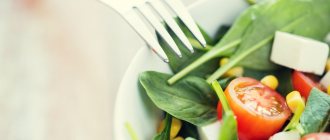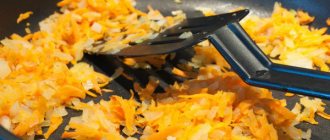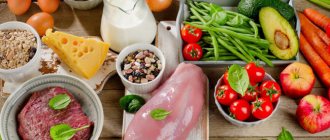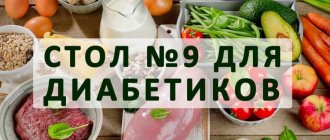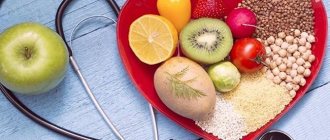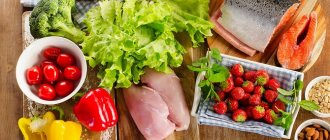Detailed descriptions of products for the keto diet
Meat
Meat
While unprocessed meat is low in carbohydrates and suitable for the keto diet, organic, grass-fed meat may be even healthier. It's worth remembering that the keto diet is a high-fat diet, not a high-protein diet, so you don't need huge amounts of meat. Excess protein (more than your body needs) is converted to glucose, which makes it harder for your body to enter a state of ketosis, so keep your meat portions small. Please note that processed meats (sausages, sausages, canned meats, ham, meatballs) contain a lot of carbohydrates and should be avoided.
Fish and seafood
Fish
Fish and seafood are ideal for a ketogenic diet, especially fatty fish such as salmon. However, avoid breading as it contains carbohydrates. Wild caught fish is best (scientific study).
Eggs
Eggs
Eggs on a keto diet are suitable for consumption in any form - boiled, scrambled, scrambled. Buying organic or pastured eggs may be the healthiest option.
How it works?
We used to think, or rather, we were so often told, that glucose is needed to start metabolism. Where can I get it? Of course, in foods with a lot of carbohydrates - cereals, whole flour, fruits.
Try a more gentle diet, but similar in principle to keto - low carb high fat or lchf diet (high fat low carbohydrate).
However, in this case, the body burns these quick and long-lasting carbohydrates without touching the existing fat at all. It is, as it were, put aside for a “rainy day” and is an emergency reserve, which greatly upsets us.
Receive a book as a gift >
The Ketogenic diet is based on a lack of carbohydrates. As soon as the body realizes that there is not enough fast fuel, it takes on the resources that are already available, that is, our deposits on the sides and hips.
Ketosis sets in - the body takes energy from fats. Sounds like a dream.
Oils and sauces
Don't be afraid to eat fat on a keto diet, most of your calories on a ketogenic diet should come from fat. Most likely, you will get the bulk of your fats from natural sources such as meat, fish, and eggs. However, also use oil in cooking: butter or coconut oil, you can add a lot of olive oil to salads. Sauces containing fat, such as béarnaise or garlic sauce, are allowed. Read our separate extensive article: fats on the keto diet, sauces and oils: what is possible?
Don't be afraid to eat fat on the keto diet (scientific study).
Calculation and achievement of the BZHU standard
You may think that you can successfully switch to a ketogenic diet without counting macronutrients, but this is not true. Correct calculation of BZHU is the most important aspect of switching to keto nutrition.
Monitoring your macronutrient intake may seem like a hassle and tedious task, but it is absolutely essential during the first few weeks of the ketogenic diet. This eating pattern is likely completely different from the one you followed previously. This way, by tracking your macronutrients, you get feedback so you can adjust your diet for best results.
Whatever diet you have followed in the past, the keto diet is definitely the most specific. The average Westerner will have to cut carbohydrates, decrease or increase proteins, and need a lot more fat. If you've been on a bodybuilding diet, your fat intake will skyrocket to alarming levels and your protein intake will drop dramatically.
Reducing proteins? Yes, that is right. The keto diet is based on a limited amount of carbohydrates, plenty of fat and moderate protein intake.
The nutritional content of the daily diet for most people will be as follows:
- Carbohydrates: 5-10%
- Fats: 70-75%
- Proteins: 15-20%
What to count first? The norm of carbohydrates and proteins. For beginners, it is recommended to consume no more than 50 g of carbohydrates daily. Experienced athletes can manage with even a smaller dose without any problems.
I recommend getting only 5% of your total calories from carbohydrates, which is usually about 30g. “What, you can’t even have a salad?” — some people are indignant and panic, and this is understandable. Therefore, I suggest considering purely digestible carbohydrates (total carbohydrates minus fibrous carbohydrates). For example, an avocado contains 12 g of carbohydrates, but 10 of them are fibrous. Therefore, we have only 2 g of digestible carbohydrates. Likewise, green leafy vegetables are nutritious and rich in fibrous carbohydrates. Therefore, you can overeat on them without exceeding the required carbohydrate limit.
When it comes to protein, athletes on a ketogenic diet are often advised to consume 1.3-2.2 g per kg of lean muscle mass rather than body weight. Below is an approximate calculation of protein requirements for an 82-kg heavyweight with 15% subcutaneous fat:
- 82 kg x 0.15 = 12 kg fat
- 82 kg – 12 kg = 70 kg dry weight
- 70 kg x 1.3 g = 91 g
- 70 kg x 2.2 g = 154 g
- Protein intake level = 91-154 g per day
If you don't know your body fat percentage, you can either measure it or use a calorie calculator and multiply your daily intake by 0.15-0.20 to calculate your protein intake.
Why is the keto diet so low in protein?
Those who are accustomed to calculating their protein needs based on total body weight, and not just dry weight, may be skeptical about a diet that involves almost halving the protein intake.
From myself I can say that: “At first I was very afraid of losing muscle mass due to reduced protein levels. But I didn’t lose an ounce of muscle, and even gained lean muscle. How did this happen? This is all due to the fact that ketones are able to accumulate protein, so there is no need to overeat tons of protein foods.”
What happens if you exceed the norm? Nothing special: just say goodbye to ketosis! Some amino acids are gluconeogenic, which means they take part in the synthesis of carbohydrates.
In other words, the effect of increased consumption of both proteins and carbohydrates is the same. Therefore, once you understand your own level of ketosis, you can experiment with your protein intake. I stick to 20%.
Vegetables
Vegetables are an excellent and tasty fat option to eat on a ketogenic diet, and they can be eaten fresh or frozen. Choose vegetables that grow above the ground (learn why here), especially leafy and green foods: cauliflower, cabbage, avocado, broccoli and zucchini. You can fry vegetables in butter, then add them to a salad dressed with olive oil. Vegetables add more variety, flavor, and color to your keto meals. Many people start eating more vegetables after being introduced to the keto diet, as vegetables replace pasta, rice and potatoes.
Whogenic diet for beginners - menu examples
Breakfast Option #1: Scrambled Eggs with Sautéed Vegetables and Bacon
- Butter or vegetable oil - 1 tbsp. l.
- Scrambled eggs with butter from 2 large eggs
- Bacon – 2 slices
- Spinach – 3/4 tbsp.
- Mushrooms – half a cup (sauteed with spinach in bacon fat)
Nutritional value per serving
- Calories – 774
- Fat – 56 g
- Carbohydrates – 5 g
- Protein – 25 g
Breakfast option #2: Egg-free breakfast
- Snack sausage – 28 g (make sure there is no sugar)
- Paprika – 1 tbsp. (fried in 1 tbsp olive oil)
- Pepper Jack cheese – 28 g
Nutritional value per serving
- Calories – 533
- Fat – 45 g
- Carbohydrates – 9 g
- Protein – 23 g
Lunch Option #1: Taco Salad
- Minced beef 20% fat – 85 g
- Taco Seasoning – 2 tsp.
- Shredded romaine lettuce – 2 tbsp.
- Cherry tomatoes – 3
- Cheddar cheese – 42 g
- Quarter of an avocado
- Sour cream - a quarter cup
Nutritional value per serving
- Calories – 570
- Fat – 42 g
- Carbohydrates – 12 g
- Protein – 36 g
Lunch Option #2: Lettuce, Bacon and Tomato Wraps
- Romaine lettuce – 3 large leaves
- Bacon – 6 slices
- Grilled chicken – 57 g
- Cherry tomatoes – 5 small
- Monterey Jack cheese – 28 g
- Mayonnaise – 2 tbsp. l.
Nutritional value per serving
- Calories – 632
- Fat – 48 g
- Carbohydrates – 8 g
- Protein – 42 g
Dinner option #1: Pork chop with mushroom sauce and steamed asparagus
- Pork chop – 113 g
- Olive oil - half a tbsp. l.
Mushroom sauce:
- Porcini mushrooms – 3/4 tbsp.
- Butter – 1 tbsp. l.
- Chopped garlic – 1 tsp.
- Ground thyme – 1 pinch
- Heavy whipping cream - 3 tbsp. l.
- Steamed asparagus - half a cup
- Butter – 1 tbsp. l.
Nutritional value per serving
- Calories – 675
- Fat – 55 g
- Carbohydrates – 9 g
- Protein – 36 g
Dinner option No. 2: Baked salmon with baked stuffed “potatoes”*
- Atlantic salmon – 113 g (with half a tablespoon of butter)
- Steamed cauliflower puree – 3/4 tbsp.
- Butter - 1-1/2 tbsp. l.
- Sour cream – 2 tbsp. l.
- Bacon – 1 slice
- Green onions – 1 tbsp. l.
- Cheddar cheese – 42 g
Note : *Combine all ingredients except salmon and bake at 177 degrees until golden brown.
Nutritional value per serving
- Calories – 653
- Fat – 53 g
- Carbohydrates – 6 g
- Protein – 38 g
Dairy
Butter and high-fat cheese are good for the keto diet, and high-fat yogurts can be consumed in moderation. Heavy cream is good for cooking. Avoid drinking milk, as it contains a lot of milk sugar (one glass of milk = 15 grams of carbohydrates), but you can add a small portion of milk to your coffee. Be sure to avoid caffe lattes (18 grams of carbohydrates). Also avoid low-fat yogurts because they often contain a lot of added sugar. Keep in mind that regularly snacking on cheese when you're not hungry is a common mistake that can slow down your weight loss process.
Principles of dietary nutrition
To normalize intestinal function and prevent constipation, you need to adhere to the rules of a balanced diet:
- Maintain drinking regime . Drink at least two liters of clean water per day. Drink water in the morning on an empty stomach, and before each meal. The liquid helps soften stool and improves the passage of food through the intestines.
- Eat small meals . Eat food often: 4 to 6 times a day, in small portions. Fractional meals facilitate the process of digesting food and do not burden the gastrointestinal tract.
- Eat more fiber . Dietary fiber affects intestinal receptors and enhances peristalsis. This promotes better movement of feces through the intestines and facilitates the process of defecation.
- Avoid harmful foods . Excluding fast food and food containing preservatives from the diet has a beneficial effect on the condition of the intestines during constipation.
The basis of table number 3 includes products with a laxative effect. They enhance peristalsis and accelerate feces excretion. The dietary table excludes the consumption of foods that contribute to the activation of decay processes. These include, for example, fried foods, as well as foods with a high concentration of essential oils.
Nuts
Nuts can be consumed in moderation on a keto diet, but be careful when using nuts as a snack as it is very easy to eat far more than you need to satisfy. Also keep in mind that cashews are relatively high in carbohydrates, with pecans, walnuts, coconut, almonds, hazelnuts, and macadamia nuts being the best options. Read our separate extensive article: nuts on a keto diet: which ones can you eat?
What to eat: menu for the week
I have made it easier for you to find recipes and have compiled a menu for the week. If desired, the ingredients can be changed and supplemented every day. This is one example of what you can eat. You have the right to create your own sheet or find other options on the Internet. The main thing is that you feel tasty, satisfying and comfortable.
Monday:
- In the morning, 2 boiled eggs and armored coffee (with butter), a handful of nuts.
- For lunch, 100 grams of fatty fish (mackerel, salmon, chum salmon, salmon) with a small bowl of vegetables seasoned with oil (broccoli, cauliflower, peppers or cucumbers).
- For dinner, a salad of spinach, shrimp, avocado and cheese (sugar-free mustard and sour cream as a dressing) + minced pork cutlet.
Don't forget to drink water throughout the day.
Tuesday:
- We start with scrambled eggs (3 eggs) in coconut oil with pieces of meat (for example, well-composed ham, bacon), and snack on a handful of cashews.
- For lunch we try a Georgian dish - mushroom caps with cheese inside plus green vegetables.
- In the evening I offer vegetable soup (without potatoes) with meat broth.
Berries
On a keto diet, low fructose berries are okay to eat in moderation. Berries with whipped cream are a popular keto dessert. Read our separate extensive article: fruits and berries on keto: which ones are possible?
Spices and seasonings
Spices
You can always: apple cider vinegar, Ceylon cinnamon, cilantro, cocoa powder, coconut aminos (if not intolerant), ginger, mustard, oregano, parsley, rosemary, sea salt, thyme, turmeric, vanilla pods.
Beware of added sugars and high glycemic sweeteners found in commercial spice or seasoning blends. Carefully study the composition of such seasonings; they should not contain additives such as sugar, milk powder, potato or corn starch, or monosodium glutamate. By the way, you can just as easily prepare any ready-made seasoning mixture yourself. Table salt often contains fillers and anti-caking agents that are not listed on the package, so it is better to choose sea or Himalayan pink salt.
Beverages
- Water is the most basic drink on a keto diet; you can drink regular boiled or sparkling water. You can add natural flavors to your water drink, such as chopped cucumbers, lemons, or limes. If you're experiencing headaches or keto flu symptoms, add a little salt to your water.
- Coffee - no added sugar, you can add a small amount of milk or cream. To get extra energy from fats, add butter or coconut oil to your coffee, check out our Bronecoffee recipe. Please note: If your weight loss slows down, reduce the amount of cream and butter in your coffee.
- Tea is a good drink on a keto diet, whether it's black, green, mint or herbal tea, feel free to drink a variety of teas. Sugar should not be added to tea.
- Bone Broth – Hearty, nutrient-dense, and easy to make, homemade bone broth is a great drink to drink on a ketogenic diet. Add a little butter to the broth for extra energy.
Read our separate extensive article: Keto Drinks: Best to Worst
For special occasions
You decide for yourself whether you should consume the following products or not. By consuming the following foods, your weight loss may slow down slightly.
Alcohol: preferably dry wine (dry red or white wine), champagne, whiskey, brandy, vodka and sugar-free cocktails. Read our separate extensive article: What kind of alcohol can you eat on a keto diet?
Dark chocolate : A small piece of dark chocolate with a cocoa content higher than 70% will definitely not hurt you. Try making a dish with a small portion of 85% chocolate grated on top of the berries with whipped cream. Read our separate extensive article: Keto snacks and snacks: what is possible?
List of prohibited foods on the ketogenic diet
Sugar is strictly prohibited on the keto diet. Avoid sugary sodas (Coca-Cola, Pepsi, Sprite, Fanta), fruit juices, sports drinks and vitamin water. Avoid sweets: candy, cakes, cookies, candy bars, donuts, ice cream and breakfast cereals. Read food labels for sugar content, especially in sauces, condiments and drinks. Honey and all kinds of syrups are also sugars. Ideally, try to avoid or limit artificial sweeteners
Starch. On a keto diet, you cannot eat foods containing starch - bread, pasta, rice, potatoes, chips, porridge, muesli, and so on. Avoid whole grains. Vegetable legumes in the form of grains or beans (peas, beans, soybeans, lentils) and in the form of green pods (green beans, peas) contain a lot of carbohydrates. Small quantities of certain root vegetables (other than potatoes) may be acceptable.
Beer is “liquid bread”; beer contains a lot of carbohydrates that are quickly absorbed by the body and is absolutely not suitable for the keto diet.
Fruits contain a lot of sugar and are not suitable for consumption on a ketogenic diet; treat fruits as negatively as you treat candy. Find out more about fruits in a separate article.
Margarine is a commercially produced imitation butter that is very high in omega-6 fat. We advise you to avoid margarine on a keto diet; it has no obvious health benefits. In addition, many people believe that margarine tastes worse than butter. High omega-6 content may cause the development of asthma, allergies, and inflammatory diseases (scientific study).
Keto diet: fashionable? Yes. Need to? Question
The keto diet is a low-carbohydrate, high-fat diet. It is credited with magical properties: they say that it will not only help you lose weight forever, but will also rebuild your metabolism and get rid of health problems. What is it really? Olya Tretyakova understands.
The popularity of the keto diet is off the charts: for this query, Google displays almost half a million links with tips, meal plans and a list of allowed foods.
Gwyneth Paltrow and Halle Berry are on the keto diet. It is also known that it was this food system that Alicia Vikander adhered to when preparing for her role in the film Tomb Raider: Lara Croft. But is it worth getting on it for a person who does not plan to surprise Hollywood and rob tombs? For example, someone like me?
Experts helped me understand this issue:
- Ksenia Selezneva, Ph.D., Head of Dietetics, EMC Clinic.
- Irina Urnova, beauty director of Esquire magazine, nutrition consultant.
- Yuri Poteshkin, PhD, medical endocrinologist.
- Alisa Fuzeeva, nutritionist.
Research links from the article “The Ketogenic Diet: Probably Not for You.”
What is the keto diet?
There are several types of low-carb nutrition - from liberal LCHF (low-carbohydrate high-fat) to extreme carnivore - "carnivore nutrition", in which the diet contains only animal products.
The keto diet falls roughly in the middle between these extremes. This is a low-carb, very high-fat diet. According to various estimates, fats should occupy up to 70-80% of the diet. For this, we are promised an increase in life expectancy by 10 years, increased energy and productivity, and healing from cancer.
How does keto work?
We typically get energy from glycogen, which is obtained from carbohydrates and stored in the muscles and liver. When you switch to a high-fat diet, your metabolism changes. Instead of glucose, the body begins to consume ketones as an energy source, molecules that the liver produces in the absence of glycogen. That is, in fact, in the absence of carbohydrates, our body will receive energy from an alternative source - fats and proteins.
To switch to this alternative source of nutrition, you need to rid the body of glycogen residues and force it into a state of ketosis. This is exactly what a diet high in fat, moderate in protein and minimal in carbohydrates should help with. Different sources determine the dose of carbohydrates to be 20-30 g per day. This corresponds to approximately one and a half slices of bread or 50 g of buckwheat. The rest of the diet is fatty meat, fish, butter, nuts and eggs.
In the 20s of the 20th century, the keto diet was used for children with epilepsy. However, almost a hundred years have passed since then, and today, according to a report published in the journal Epilepsy, the keto diet is one of the most rarely used methods of combating this disease.
A new round of popularity for keto came from studying the nutrition of the peoples of the Far North. “Their diet consists almost entirely of meat and fat,” says Irina Urnova. “Interest in this diet grew when it became clear that these people have extremely low rates of cardiovascular disease, degenerative brain diseases (dementia, Alzheimer’s, Parkinson’s) and type 2 diabetes.”
But to what extent this depends on nutrition, and where is the cause and where is the effect, it is impossible to say for sure. There are no scientific studies to confirm this connection.
How to enter the ketogenic diet?
Switching to keto is not exactly a pleasant procedure. In the process of giving up carbohydrates, many experience a phenomenon called “keto flu”. “This condition is similar to a cold,” says Irina Urnova, “there are aches, drowsiness, a sore throat, and problems with stool. Most often, symptoms go away within 1-3 days.”
...Or last much longer. “It happens that adaptation lasts from 1 to 6 months, depending on what nutrition system a person followed before and to what extent he is overweight,” says Alisa Fuzeeva. Often, unpleasant symptoms are associated not so much with the transition to a different type of diet itself, but with one of its consequences - the death of candida in the body: “As it breaks down, it releases toxic substances, and this makes the person feel unwell.”
In any case, according to Fuzeeva, you need to enter ketosis wisely: measure ketones in your urine once a day and take vitamins and minerals.
Urnova also agrees about vitamins: “When switching to a keto diet, a person initially loses a lot of water, which is retained, among other things, by glycogen in the muscles. Water takes with it minerals - electrolytes: magnesium, potassium, zinc and sodium. Therefore, their deficiency should be replenished.”
Contraindications for the keto diet
“It is absolutely not suitable for diseases of the thyroid gland and for those who adore carbohydrates,” Fuzeeva lists. “And also for those who expect quick results, because this is not always possible.”
“Also, those who have acute problems with the kidneys and liver, pancreatitis, liver dysfunction, porphyria, type 1 diabetes should not try it on their own,” continues Urnova’s list.
Keto diet menu
It will also be difficult for those who, in principle, love to eat. The list of permitted products is small, the variety of proteins is generally very limited by their quantity, and the daily protein intake should not exceed 20%. But not everyone wants to eat exclusively fat.
Harmful? Healthy? Or is it still harmful?
There are conflicting opinions on this matter. Supporters of evidence-based medicine most often speak out against it. According to Yuri Poteshkin, for some, the keto diet can be deadly: “People with diabetes may develop ketoacidosis when switching to this type of diet instead of ketosis. This is a condition that develops when there is a deficiency of insulin. In this case, you can die within 24 hours. The person loses consciousness, then resuscitation. And only if someone finds the victim in time and realizes that he needs help. The fact is that with ketoacidosis, a person emits the smell of acetone, similar to that which appears after alcohol abuse. It’s easy for outsiders to confuse one with the other, so the attitude towards a person lying unconscious on the street may be appropriate.”
But, we emphasize, this is only true for people with diabetes. An ordinary healthy person cannot develop ketoacidosis, says Poteshkin.
“Yes, ketoacidosis can affect people with certain diseases - for example, type 1 diabetics, whose body cannot cope with large amounts of ketones,” agrees Irina Urnova. “However, insulin-dependent people are people with a serious and sometimes congenital disease. They shouldn't eat high-carbohydrate foods either. On this basis alone, one cannot conclude that the keto diet is dangerous for everyone else.”
In general, there is no scientific evidence that the ketogenic diet is harmful to a healthy person. (Unless, of course, you count digestive problems: for some, this diet causes constipation, and for others, diarrhea.)
But there is no evidence that it is useful.
Perhaps because, as a way of life, she is still very young. “The ketogenic diet has spread not so long ago,” says Alisa Fuzeeva, “and it’s difficult to find people who stick to it for a long time.”
“The longest-term keto studies I’ve seen lasted 24 weeks,” adds Yuri Poteshkin. - As for the statements of people who say that they have been sitting on it for 50 years... People say whatever they want! Every day I see those who claim that they don’t eat anything at all - and for some reason they don’t lose weight.”
In addition, there is a difference between a therapeutic keto diet, that is, one that is prescribed for medical reasons, and a regular nutritious one - for healthy people, Urnova assures. The second is milder, does not require extremes and is often combined with a regular low-carb diet: “Many people switch to keto for periods: after 2-3 months, they go back to a more liberal version of low-carbohydrate, high-fat (LCHF) nutrition.” The amount of carbohydrates allowed for LCHF is greater - from 50-70 to 100-120 g per day. But also, of course, not at the expense of sweet rolls, but at the expense of high-quality whole foods - vegetables, fruits, berries, and sometimes some cereals.
Who needs a keto diet anyway?
Research shows that ketosis, without which there is no keto diet, is effective under extreme stress: it prevents oxygen poisoning among deep sea divers and makes ultramarathon runners more resilient.
However, there is again no consensus on this matter. One study found that the keto diet may slightly improve endurance performance (specifically in mountain bikers). And according to another study, it does not improve, but, on the contrary, reduces performance.
Does the keto diet protect against disease? There are also mixed opinions on this matter. There seems to be evidence that it can help treat cancer. However, according to the publication “Medical Oncology”, the keto diet not only helps with this, but can also cause unwanted side effects.
However, ordinary people are not athletes! — they still switch to the keto diet.
For what? According to Irina Urnova, who herself follows a keto diet, “including for the sake of clarity of mind, good health and mood, and restful sleep.” Although, as a health benefit, sometimes it is enough to simply follow a low-carbohydrate, high-fat diet - eat 50-70 g of carbohydrates per day: “Some even with such a diet lose weight and solve certain health problems.”
Dr. Poteshkin believes that this is not worth doing: “As a lifestyle, the keto diet is a dubious decision. The keto diet is used only for medical reasons - that is, for epilepsy, and only under the supervision of a doctor. As a permanent diet, it is not physiological, because constant carbohydrate starvation is unnatural. I understand that keto dieters don't think of not eating carbs as hunger, but for the brain, that's exactly what it is. After all, the brain feeds primarily on carbohydrates. And they should be in the diet."
Will the ketogenic diet help you lose weight?
The keto diet does not promise exact numbers: “in X days you will lose Y kg,” but its adherents assure that as soon as you switch to it, the excess weight will begin to disappear.
If only because people on keto obviously eat less. Many do it only twice a day: morning and evening. During the day they do not have lunch because they do not feel hungry. Fats saturate and take longer to break down, explains Irina Urnova.
Scam or truth?
According to a recent study, all diets in the world work exactly the same: they simply create a calorie deficit. That is, for weight loss it is not so important what exactly you stop eating: carbohydrates, fats, proteins, or simply reduce the amount of food. “But a person is designed in such a way that it is easier for him to believe in a miracle diet, rushing to extremes, than to come to an agreement with himself once and for all and constantly eat rationally,” explains Ksenia Selezneva. – That is why all kinds of diets were, are and will be popular. And each new one will promise lightning-fast weight loss once and for all.”
Have you tried the keto diet? What kind of diets were you on? Which ones helped and which ones were useless?
Eat natural food!
Focus on minimally processed, good quality natural foods! Ideally, the products you buy should not even contain a list of ingredients, or the list should be short.
Industrially unprocessed natural food is what our ancestors have eaten for millions of years, and what the human body has evolved to adapt to. Processed foods, such as refined carbohydrates, increase the rate of absorption and reduce the amount of nutrients in the food. Thus, we get food that is unnatural for our body. And thus, there is a risk of side effects for health.
How low carb is the keto diet?
Keto is a low-carb diet, not a no-carb diet. So how many carbs can you eat in a day? Allowed consumption ranges from zero carbohydrates to 100 grams per day. For maximum weight loss benefits, it is recommended to stay below 20 grams per day . Below are three examples of what a plate of food might look like depending on how many carbs you eat per day.
Type of plate with food depending on the amount of carbohydrates in grams
Try a short post or a bold post.
Another way to get into ketosis is to go without food for several hours.
In fact, many people experience mild ketosis between lunch and breakfast.
Children with epilepsy sometimes fast for 24 to 48 hours before starting a ketogenic diet. This is done to get into ketosis quickly so that the attacks can be shortened faster.
Intermittent fasting, a dietary approach that involves regular short periods of fasting, can also induce ketosis.
Additionally, "fat fasting" is another ketone stimulation approach that mimics the effects of fasting.
This involves consuming about 1,000 calories per day, 85-90% of which come from fat. This combination of low-calorie and very high-fat intake can help you achieve ketosis quickly.
A study conducted in 1965 showed significant fat loss in overweight patients following obesity. However, other researchers note that these results have been greatly exaggerated.
Because fat fasting is so low in protein and calories, it should be maintained for a maximum of three to five days to prevent excessive muscle loss. It can also be difficult to stick to for more than a couple of days.
How much fat should you eat on a keto diet?
The body has two main sources of energy: carbohydrates and fats. Remove most carbohydrates and the body switches to burning fat for energy. Fat burning comes from your body's fat stores and fat from your food (such as butter or olive oil). How much fat should you eat? It is necessary to focus on your well-being and evaluate the satisfaction of your feeling of hunger. Eating too much fat will slow down your weight loss, but consuming too little fat will leave you feeling tired and hungry. Take as much fat as you need to feel good.
Include coconut oil in your diet
Eating coconut oil can help with ketosis.
It contains fats called medium chain triglycerides (MCTs).
Unlike most fats, MCTs are quickly absorbed and delivered directly to the liver, where they can be immediately used for energy or converted into ketones.
In fact, it has been suggested that consuming coconut oil may be one of the best ways to increase ketone levels in people with Alzheimer's disease and other nervous system disorders.
Although coconut oil contains four types of MCTs, 50% of its fat comes from a type known as lauric acid.
Some research suggests that fat sources with a higher percentage of lauric acid may induce more sustained levels of ketosis. This is because it is metabolized more gradually than other MCTs.
MCTs have been used to induce ketosis in children with epilepsy without carbohydrate restriction as radically as the classic ketogenic diet.
In fact, several studies have shown that a high MCT diet containing 20% of calories from carbohydrates produces effects similar to the classic ketogenic diet, which provides less than 5% of calories from carbohydrates.
When adding coconut oil to your diet, it is recommended to do so slowly to minimize digestive side effects such as stomach cramps or diarrhea.
Start with one teaspoon per day and work up to two to three tablespoons per day for a week. You can find coconut oil at your local grocery store or buy it online.
Other visual keto guides
To learn more about specific topics—like what fruits or nuts you can eat on a ketogenic diet—check out our handy visual guides.
Vegetables
Nuts
Alcohol
Beverages
Fruits and berries
Snacks and appetizers
Oils and sauces
